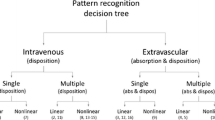Abstract
The need for objective design of pharmacokinetic experiments aimed at model discrimination is argued. A sequential design strategy based on information theory is outlined. The characteristics of this strategy and its applicability to pharmacokinetic experiments is examined by means of computer simulated experiments. The limitations of the technique are discussed and alternative approaches outlined.
Similar content being viewed by others
References
C. M. Metzler, G. L. Elfring, and A., J. McEwen. A users manual for NONLIN and associated programs. Upjohn, Kalamazoo, Mich., 1974.
F. Mori and J. J. Di Stefano III. Optimal nonuniform sampling interval and test input design for identification of physiological systems from very limited data.IEEE Trans. Autom. Control 24:893–900 (1979).
L. Tornoci and B. Kanyar. D-Optimal design in case of exponential and sigmoid response functions. In L. Fedina, B. Kanyar, and B. Kocsis (eds.),Adv. Physiol. Set, Vol. 34. Mathematical and Computational Methods in Physiology, Pergamon Press, Budapest, 1981, pp. 185–192.
L. Endrenyi. Design of experiments for estimating enzyme and pharmacokinetic parameters. In L. Endrenyi (ed.),Kinetic Data Analysis, Plenum Press, New York, 1981, pp. 137–167.
B. Mannervik. Design and analysis of kinetic experiments for discrimination between rival models. In ref. 4In, pp. 235–270.
N. R. Draper and H. Smith.Applied Regression Analysis. Wiley, New York, 1966.
H. G. Boxenbaum. Pharmacokinetics of isoniazid in man. PhD thesis, University of California, San Francisco (1973).
H. Akaike. A new look at the statistical model identification.IEEE Trans. Autom. Control 19:716–723 (1974).
K. Yamaoka, T. Nakagowa, and T. Uno. Application of Akaike's information criterion (AIC) in the evaluation of linear pharmacokinetic equations.J. Pharmacokin. Biopharm. 6:165–175 (1978).
P. D. Hill. A review of experimental design procedures for regression model discrimination.Technometrics 20:15–21 (1978).
V. V. Fedorov.Theory of Optimal Experiments. Academic Press, New York, 1972.
G. E. P. Box and W. J. Hill. Discrimination among mechanistic models.Technometrics 9:57–71 (1967).
W. G. Hunter and A. M. Reiner. Designs for discriminating between two rival models.Technometrics 7:307–323 (1965).
C. E. Shannon. A mathematical theory of communication.Bell System Tech. J. 27:379–423, 623–656 (1948).
P. G. Hoel.Introduction to Mathematical Statistics. Wiley, New York, 1962.
A. Dunne and L. Lacey. Model discrimination: posterior probabilities.Can. J. Chem. Eng. (1984), in press.
International Mathematical and Statistical Library, Houston, Texas (1980).
M. Gibaldi and D. Perrier.Pharmacokinetics. Marcel Dekker, New York, 1982.
Author information
Authors and Affiliations
Additional information
This work was supported by the Medical Research Council of Ireland.
Rights and permissions
About this article
Cite this article
Lacey, L., Dunne, A. The design of pharmacokinetic experiments for model discrimination. Journal of Pharmacokinetics and Biopharmaceutics 12, 351–365 (1984). https://doi.org/10.1007/BF01061725
Received:
Published:
Issue Date:
DOI: https://doi.org/10.1007/BF01061725




